Fleeting Beauty
The story of an incomparable replica - and tragedy
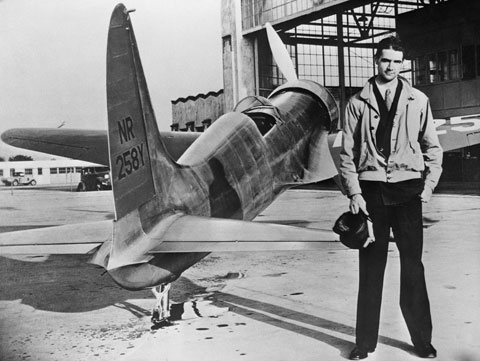
“Homebuilt” airplanes range from crude machines to articles combining the best of craftsmanship and aesthetics. But one of them stood alone: the incomparable H-1 Racer built by Jim Wright and a team of skilled craftsmen in a small town in western Oregon. That airplane stamped itself into the memory of everyone fortunate enough to see it as the most beautiful airplane they’d ever seen, or were likely to see, during the all-too-short period in which it flew.
As a young man, Jim Wright saw a photograph he never forgot. Staring out of the black-and-white image was a young Howard Hughes, leather flying helmet in hand, standing in front of the airplane he’d just flown to set a new transcontinental speed record.
Although the photographer intended a portrait of the man, Wright was fascinated by the elemental beauty of the airplane in the background. It was a slender, smooth, low-wing monoplane, engineered and built for speed, and its lines engraved themselves in his memory.
The H–1 came into existence because Hughes wanted to be the fastest man alive, and he had the brains, will, and money to make it happen. Hughes hired aircraft designer Dick Palmer, assembled a crew of engineers and craftsmen (led by engineer and aircraft mechanic Glenn Odekirk), and put them to work building an airplane that would make his desires into reality. What emerged was as much a work of art as engineering. A clean flush-riveted, monocoque aluminum fuselage was mated to a mirror-smooth 26-foot, 11-inch wood wing with sweeping metal fairings at the intersection. In the nose a slim radial engine was enclosed in a gently swelling cowl. Both the main gear and the tail skid retracted. The small canopy sat aft of the wing and blended into the aft fuselage. In an era where OX-5s were still common and the U.S. Navy had just ordered a portly biplane as its new front-line fighter, the H–1 was revolutionary.
In 1935, Hughes, who had been intimately involved in the design and construction, made a couple of brief test flights in the airplane. He encountered some propeller problems (the sketchy records are not specific), but those were soon put right. On September 13, 1935, he established a new three-kilometer speed record, flying over a course near Santa Ana, California, at an average 352 mph. On the last pass the engine stumbled and quit; the evidence suggests Hughes had simply run out of fuel. He turned toward the airport, but with its short wing the H–1 was built for speed, not gliding. He landed short, wheels up, in a bean field.
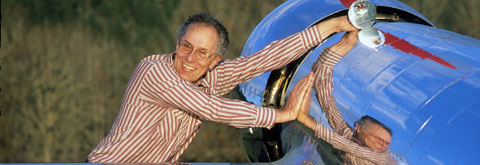
In 1937 the repaired airplane re-emerged with a longer, 32-foot wing designed for cross-country flying. With its supercharged engine, an oxygen system, and 280 gallons of fuel (the airplane had a range of 4,000 miles), Hughes intended to climb high, catch a tailwind, and break the transcontinental speed record. Given that the H–1 could cruise around 400 mph at 24,000 feet, it seemed likely that Hughes would soon traverse the continent faster than any human ever had.
He accomplished his goal on January 19, 1937. He does not seem to have made any special preparations other than keeping the airplane fueled and ready. When he appeared at the airport in Los Angeles in the early hours of the morning, his crew, familiar with Hughes’ idiosyncrasies, was not surprised. They fired up the engine and he left—destination unspecified. Seven hours, 28 minutes, and 25 seconds later, he reappeared over Newark, New Jersey. The oxygen system had failed, forcing him down from the most favorable altitudes, and he averaged 332 mph for the nonstop flight. It was an epic flight by an exceptional pilot.
Hughes had a brief day in the media spotlight, but having set the record, he went on to other things and the H–1 simply sat in Newark. A year later, Allen Russell, William Randolph Hearst’s company pilot, flew it back to California. It never flew again. It was preserved at the Hughes Aircraft plant in Culver City until 1975. Today it can be seen at the Smithsonian Institution’s National Air and Space Museum in Washington, D.C., where it rests in perfect condition with 40.1 hours total time in its logbooks.
An H–1 of his own
In the mid-1990s Wright and his wife, Betty (like Hughes, owners of a successful tool company), found themselves in a position to pursue Jim’s dream of owning and flying an H–1. The Smithsonian was not interested in selling, so the only way to do it was the same way Hughes did. Wright set about gathering the information, material, and people he would need to build an H–1, serial number two.
A major hurdle was finding the unusual engine: a Pratt and Whitney R-1535. The unique shape and size of the 14-cylinder, two-row geared radial meant there simply was no alternative powerplant. Only 2,900 Twin Wasp Juniors were ever manufactured, so Wright was quite surprised when his very first phone call turned one up.
“The owner wanted more than I was willing to pay,” Wright said. “I figured that finding another couldn’t be that hard. As it turned out, that first one was the only available example left in the world, and we ended up paying full price.”
The search for a skilled crew, willing to dedicate themselves to a prolonged and intense project, was similarly successful. A big, quiet man named Ron Englund showed up to apply. A flight instructor and pilot, he’d restored several antique aircraft. His résumé was unique—and it wasn’t written on paper. Instead, it was an exquisite, fully functional, six-inch-diameter radial engine that he’d built from scratch. Wright hired him on the spot, and Englund became his foreman, overseeing a crew of four or five craftsmen on a project that was to consume the next five years.
Even with the engine in hand, Wright knew that no plans or blueprints for the H–1 existed, and construction photographs—even photographs of the completed airplane—were rare. The only definitive source of information was the original airplane. The Smithsonian, after some negotiation, granted Wright permission to inspect, measure, and photograph the H–1. Members of the Wright crew made four trips to Washington, D.C., and would arrive at the museum at 5 a.m., armed with large wooden calipers, tape measures, sketch books, and lots of cameras.

What they found awed them. The craftsmanship was simply superb. Many aircraft of the era, especially racers, were made quickly and crudely, but every aspect of the H–1 was engineered, constructed, and finished to the highest standard. Wright’s team could do no less, and members dedicated themselves to re-creating the Racer (Hughes’ preferred name) in both spirit and article. Every part of the new airplane would have to meet the standards set by the men who had built the original.
With enough basic measurements to get started, it was time to cut metal. Englund oversaw the fabrication of the first components: the engine mount and exhaust system. These were installed on a plywood firewall on the front end of a complete plywood mock-up of the fuselage—a big piece of work in its own right. Then he turned his attention to the cowl.
Wright’s intention was to involve the best craftsmen he could find. If you want a large, perfectly formed aluminum cowl, the best is Jim Younkin. Well known for his museum-quality work on Staggerwings and his homebuilt “Mullicoupe,” Younkin had harbored his own ideas about building a Hughes replica. Now that someone else was tackling the project, he was eager to be part of it. Younkin and partner Pat Nelle spent 12 months fabricating the 44.5-inch-diameter aluminum cowl. The project included dozens of fasteners and carefully located rods and was “the toughest metal forming project we’ve ever tackled,” says Younkin.
Meanwhile, there was the matter of the wing. That’s wing, singular. The H–1 uses a one-piece wing joined permanently to the bottom of the fuselage. To complicate things further, the wing contains four fuel tanks, a metal split flap nestled into the trailing edge, drooping ailerons, and a hydraulic retractable main landing gear long enough to provide clearance for a propeller 10 feet in diameter. After the complicated skeletal structure is complete, the whole thing is covered in layers of one-eighth-inch mahogany plywood laminated together, up to a half-inch thick. Fortunately, two of the world’s best candidates for the job lived just a few miles to the north. Steve and Liz Wolf were able to re-create the wing in 20 months of steady work. Sighting down the finished product revealed a surface that resembled polished marble.
The wing construction done, Englund tackled one of the most challenging problems of the project. The landing gear was the first hydraulically actuated retractable design used on any land airplane. “It took our team, even with the advantage of a computer and a CAD system, several tries before we really understood the geometry at work in that landing gear,” he said. “Much of the mechanism in the original airplane is partially hidden and all of it is unique because there weren’t any off-the-shelf parts.”
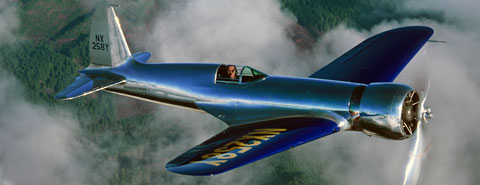
The leg is a narrow box in cross-section, built of thick aluminum plates riveted and bolted together. Contained within is a long oleo strut. The upper end of the leg pivots around a complex trunnion bolted into the wing. There are no gear doors. A recess is built into the bottom of the wing, and the gear leg fits so closely that the gap between leg and wing skin is barely visible. Small “grass-cutters”—wheel covers that flip sideways from the axles when the gear is extended—close to cover the tires.
Despite looking like a perfectly smooth curve, the fuselage is composed of segmented aluminum rings, changing shape slightly at every joint. Every joint is abutted and each skin is so carefully fitted that, according to Englund, “There’s no place on the airplane where you can fit a .004-inch feeler gauge between skins.” Visitors to the shop thought the fit was so perfect that not even light could get through.
The top of the aft fuselage sweeps up in a beautiful curve that simply becomes the leading edge of the vertical stabilizer. This task was turned over to metal magician Kent White. He hand-formed the two aluminum halves of the vertical stabilizer’s leading edge and found that it was not as simple as producing two mirror-image parts. Because the vertical stabilizer was offset to help counteract P-factor, the two halves were actually different shapes.
The propeller had been a source of considerable head scratching. It was apparent from period photographs that the propeller had been modified, or different propellers with different counterweights had been installed. The Wright team decided to re-create the original prop as closely as they could and deal with any problems as they arose.
Racer two
In April 2002, Wright decided to introduce the Racer to the public and held an open house at his hangar in Cottage Grove, Oregon. Several hundred people arrived to find the hangar door open, a vintage movie featuring the H–1 running on a video monitor, and John Newberry in attendance. As a young engineer, Newberry had worked on the original airplane and at the age of 93 could still remember details of cable routings, wiring runs, and even the odor of the unwashed sneakers Hughes wore while checking progress on the project.
Later in the afternoon, Wright decided to roll the airplane out of the hangar. When the deep blue wing and polished silver cowl emerged into the sunlight, conversation simply stopped. People who had spent their whole lives around airplanes brushed away tears. They would walk around it, slowly, wonderingly, and occasionally reach out and brush their fingers against a wing tip or a propeller blade, as if to reassure themselves that it was real.
On July 9, 2002, after 40,000 man-hours of skilled work, the airplane was ready to fly. For the second time in history, a tall, slender head of a tool company settled himself into the seat of an H–1 Racer, fastened the lap belt, and prepared for the aircraft’s maiden flight. With only the crew that had built the airplane in attendance, Wright aligned the gleaming cowl with the centerline of Cottage Grove’s 3,000-foot runway and slid the throttle forward. The R-1535 spun up with a snarl, the tail lifted easily, and seconds later the airplane was airborne and climbing strongly.
As Wright leveled out and the speed picked up, he found the airplane handled extremely well, but there was something wrong with the propeller. It simply wouldn’t come out of fine pitch, and the geared engine was really turning fast to keep the airplane in the air. He landed safely on the long, wide runway at Corvallis, about 40 miles north. The problem was traced to inadequate counterweights on the prop—and suddenly everyone understood what had gone wrong on the original H–1’s first flight so many years earlier.
After repairs, Wright resumed test flying. “This airplane is a big pussycat,” he said. “Stall behavior is pretty benign…at about 81 miles an hour it breaks straight ahead. Handling at speed is excellent. I wheel land it so I can see where I’m going. That demands precision because there are only a few inches of prop clearance in the wheel-landing attitude. Performance is just phenomenal. The airplane will climb over 4,000 feet per minute, and it is very fast.”
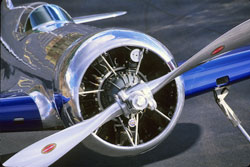 Wright flew the airplane to the National Air Races in Reno, Nevada, on September 13, 2002—67 years to the day after Hughes’s closed-course record—and posted 304.07 mph over a three-km course. The full potential of the airplane couldn’t be realized, however, because the prop still limited the amount of power the engine could deliver. When development work and testing on a new prop was complete, he intended to recapture the transcontinental record. If he had his way, on the sixty-sixth anniversary of Hughes’s transcontinental flight, another H–1 would appear over Newark and claim a new record.
Wright flew the airplane to the National Air Races in Reno, Nevada, on September 13, 2002—67 years to the day after Hughes’s closed-course record—and posted 304.07 mph over a three-km course. The full potential of the airplane couldn’t be realized, however, because the prop still limited the amount of power the engine could deliver. When development work and testing on a new prop was complete, he intended to recapture the transcontinental record. If he had his way, on the sixty-sixth anniversary of Hughes’s transcontinental flight, another H–1 would appear over Newark and claim a new record.
It never happened. In July 2003 Wright flew the airplane to the Experimental Aircraft Association’s annual AirVenture in Oshkosh, Wisconsin, where airplane lovers from all over the world could see and appreciate it. He parked it at show center and refused to even put a rope around it. He built it so people could understand what a tremendous achievement the original airplane had been. Wright encouraged visitors to run their hands over the wing and crawl underneath to see the incredible geometry of the landing gear.
Although the flight from Oregon to Wisconsin went safely, the flight home ended in disaster. During a stop in Gillette, Wyoming, Wright mentioned that the propeller was again causing problems. He was trying to get the airplane home when something, probably a propeller counterweight, went badly wrong over Yellowstone National Park.
Some witnesses later described the airplane deliberately turning away from a possible landing site occupied by tourists; other accounts paint a picture of an airplane spiraling out of control. The NTSB accident report says that evidence “suggests that one blade was still slaved to its counterweight at the time of impact and one was not.” Although Wright wore a parachute and had indicated to friends he was willing to use it, he may never have had the chance. The sudden loss of a propeller counterweight would have created an explosive vibration and may well have rendered the airplane uncontrollable. He may also have made the deliberate choice to stay with the airplane and attempt to avoid injuring people on the ground—an action that those who knew him said would be entirely consistent with the man. In either case, Wright was killed and his Racer utterly destroyed when it crashed near the Firehole River.
Jim Wright Field
Virtually everybody who had met Wright counted him as a friend, even if they’d only spoken with him for a few minutes. Kent White (quoted by Smithsonian writer Preston Lerner) described him as “a man whose fundamental energy is joy.” His death brought a surge of messages to the Racer website that lasted for weeks, mourning the loss of someone special.
Today, Englund keeps a beautifully restored Aeronca and a Fleet biplane in the hangar where he spent thousands of hours building the Racer. Photos of both the original and the re-created Racers and Wright hang on the walls. A man who does not use a lot of words, Englund simply stares into space for a few seconds when asked about his friend and former employer. The depth of feeling is apparent, and the project is still very much a part of his life. His feelings are probably best expressed by the sign outside the window, visible to every airplane that taxies by: “In 2003, the Cottage Grove airport was re-named Jim Wright Field in remembrance of a kind and gentle man of extraordinary vision.”
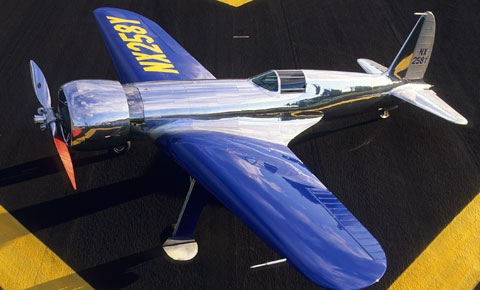
Ken Scott is a freelance writer in Oregon who works for Vans Aircraft and owns an RV–6. Photography by Chadd Slattery.


